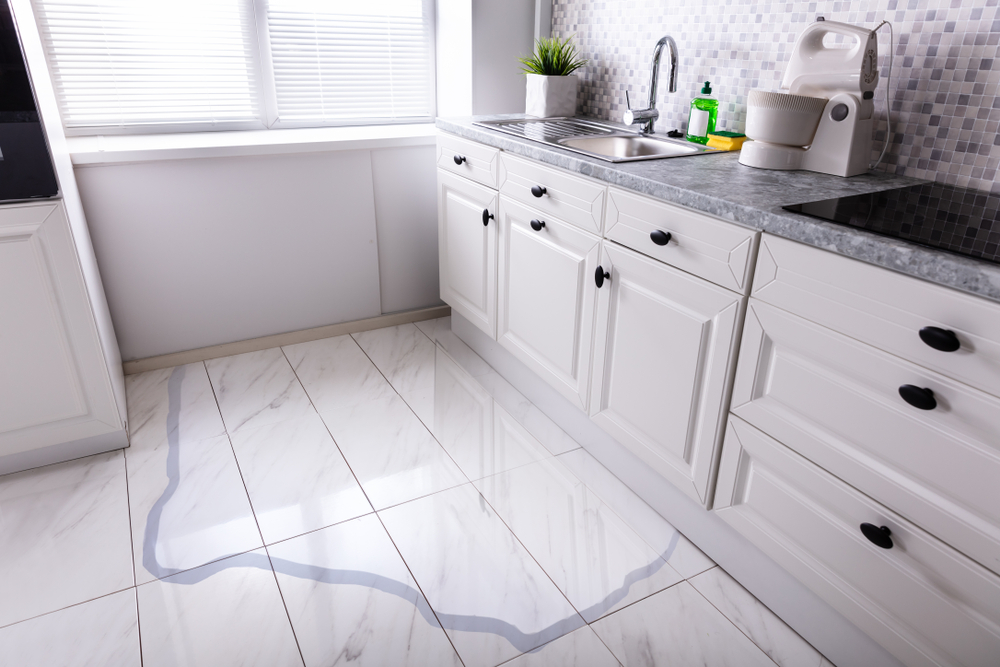Sink Flooded Kitchen
Has your sink flooded kitchen? If you have experienced a kitchen flood reach out to a trusted, local water damage restoration company for help with the flood damage.
Flooded Kitchen Floor
You come home from a long day at work, and as soon as you open the door, you know something is wrong. Water is pooled on the kitchen floor, and there is a strange smell in the air. As you race to shut off the water, you realize that the dishwasher has overflowed, flooding the entire kitchen. Now you face a daunting cleanup task.
First, you’ll need to mop up all the standing water and then disinfect the floor to prevent mold growth.
Next, you’ll need to assess any damage to your cabinets, flooring and appliances. If the water has seeped into cabinets or caused electrical damage, you may need to call in a professional to make repairs. What most homeowners don’t know is that even if you have waterproof or water resistant flooring it doesn’t stop the water from getting underneath that floor.
That is where long term damage occurs most frequently when people try and tackle floods in a kitchen. It’s imperative to have the right equipment to test and see if you have water underneath your floors and not just settle by removing the water above the floor. Those water proof floors are also very difficult to get the water out from underneath them and usually have to be removed to effectively remove the water.
And finally, you’ll need to take steps to prevent future flooding, such as checking the dishwasher regularly and clearing any clogs in the drain cleanup task and the seal around the door.
Kitchen Flooded From Dishwasher
I was in the kitchen, making dinner, when I heard a loud crash. I ran over to the dishwasher and saw that it had overflowed, water was everywhere! I quickly turned off the water and began to clean up the mess. I was so thankful that I had installed tile in the kitchen, otherwise, the water would have ruined the floors.
What I didn’t know is that water can still get underneath my floors at the edges and cause the flooring to expand and crack or even have mold grow underneath the tile. As it was, I still had to call a professional to fix the dishwasher and a remediation company to come out and test the floors for water and set fans and a dehumidifier to remove the water from under the tile. In the meantime, I made sure to empty it after every use and watch it carefully when it was running. I learned my lesson from that flooded kitchen!
Refrigerator Flooded kitchen
Homeowners know that one of the most devastating things that can happen is a refrigerator flood. And it usually happens when you least expect it, like in the middle of the night or when you’re away on vacation. Being a supply line the flooding will not stop until you turn the water off to the appliance.
The first thing you need to do is turn off the power to your fridge. Then, you need to assess the damage. If the flooding is extensive, you may need to call in a professional to help with the cleanup. However, if the flooding is minor, you may be able to clean up the mess yourself.
Start by mopping up any standing water and then wipe down all of the surfaces with a disinfectant. In the meantime, try to inspect the line to you fridge every spring when you do your spring cleaning to see if there are any signs of leaks before they happen. Physically pull the fridge away from the wall and don’t just rely on shining a flashlight around or under the fridge.
Water Damage Restoration
Water damage can strike your home at any time, and the resulting repairs that can be time consuming and expensive. That’s why it’s important to know what to do in the event of a water leak or flood.
The first step is to turn off all power to the area and call a professional water damage restoration company. If there is standing water do not walk in the area and use the outlet switches, go to the electrical panel or the power shut off outside. Restoration companies specialize in repairing homes that have been damaged by water, and they have the training and equipment needed to get the job done right.
While you wait for the restoration company to arrive your next call should be to your insurance company to start the claims process. Most insurance companies have an emergency 24 hour line that you can use to provide a claim number to the restoration company. Once they arrive on the scene, they will assess the damage stabilize the area and develop a plan for flood damage repair. This may involve removing water-damaged materials, drying out the area, and using specialized equipment to prevent any further damage like mold growth and structural damage. With their help, you can get your home back to normal in no time.

